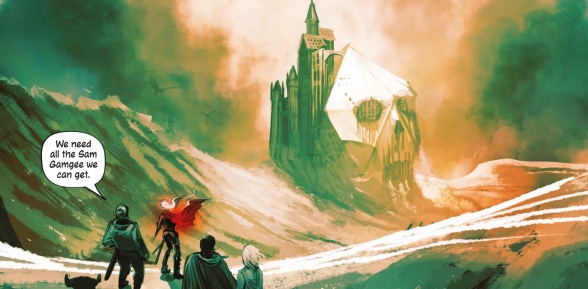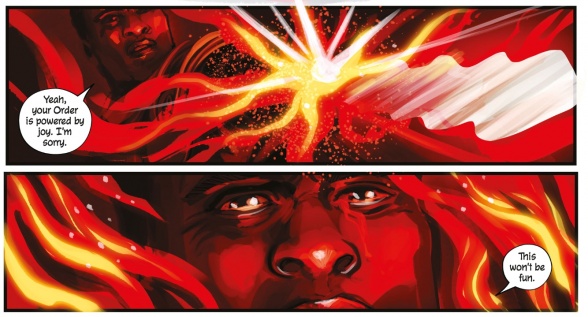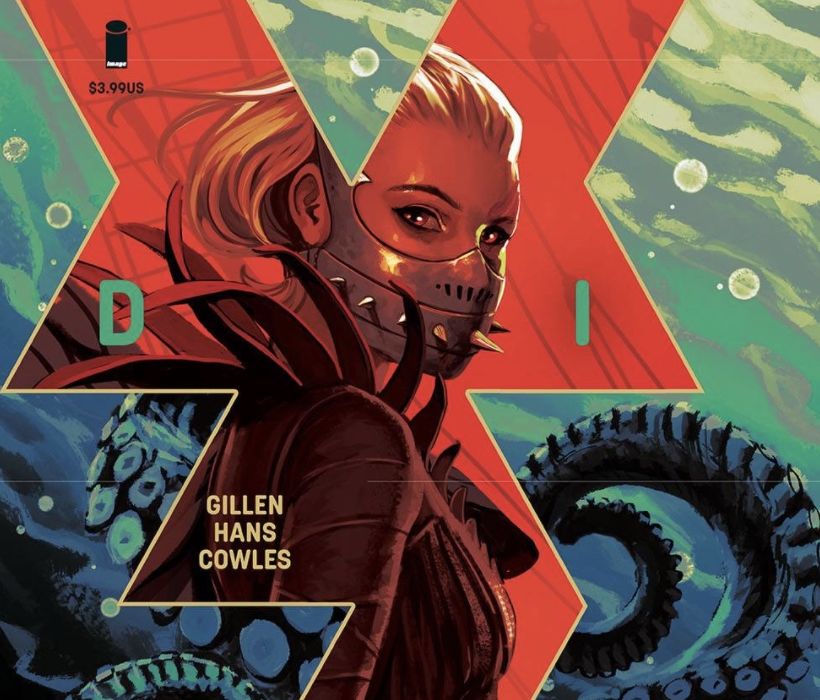There are a lot of comics out there, but some just stand out head and shoulders above the pack. With “Don’t Miss This” we want to spotlight those series we think need to be on your pull list. This week, “Die” #16 hits shelves with the first issue in our final arc and casts the friends into the ocean to pursue the most dangerous of all goals: the dungeon.
After that, who can say? The fate of Die and our world is at stake, and the creative team most definitely has some tricks in store for us. Sol would be proud.
Who’s This By?
The “Die” team includes writer Kieron Gillen (“The Wicked + The Divine,” “Peter Cannon: Thunderbolt,”) artist Stephanie Hans (“Dark Agnes,” “Black Bolt,”) and letterer Clayton Cowles (“Daredevil,” “Batman,”) and is published by Image Comics.
What’s This All About?
A group of friends play a game for Ash’s birthday. They get stuck. Years later, they reappear in their world and try to get on with their lives. As it turns out, the game – and its Dungeon Master – aren’t quite done with them yet. Ash and the Party have to return to the world to save Sol, solve a mystery or two, cope with their teenage-era decisions and get themselves out, once and for all.
“Die” blends TTRPG tropes and settings with a buffet of classic fantasy, grim humor and cultural references to capture the whims and horrors of bringing a formative childhood game to life.
(Warning: spoilers ahead.)

What Makes It So Great?
“Die” is a fascinating exploration of fantasy as a genre and as a shared, imagined space built by generations of dreamers – and the occasional fascist. Brutal and transcendent in turn, fantasy stretches our imaginations in small and lofty ways. “Die” seeks a balance between them as Gillen explores the politics at large of the world and the intricacies of personal relationships that were frayed to begin with. We take an early trip to the trenches with a bitter Tolkien, spend time with the hapless Brontës and argue politics and war with a naive H.G. Wells. Gillen works in references to Peake, Lewis and other fantasy canon giants but doesn’t rest on the brief dissonance of squaring up our world with what the team builds in these comics. Each instance has something to teach us. Ash and the others might not listen, but there’s context for understanding the ghoulish immediacy of early childhood, the fraught sexuality of our teens and the grim war-torn realities of adulthood. It’s all here.
Gillen’s focused on the frame and the workings of Die, while Hans digs into a varied and interesting aesthetic. A series like “Die” is more complex and a bigger challenge than we might think. How to blend eternal reference, dynamic action and a lot of people considering things in rooms? That might sound flip, but there’s a lot of connective tissue in between the action and some essential emotional moments – particularly with Matt – that require attention to detail. When to stretch a moment over two, three or more beats? When to shorthand movement so we can get to the highest spots on a tight page? Hans plays with angles, soft lines and an oil-paint aesthetic to bring the world of “Die” to life without too much cartooning. This is generally a serious book, and while we may slip too deep into seriousness at times the tone is largely justified.
Hans was primarily a cover artist before “Die” and that does show. Static poses are Hans’s main strength, and characters can appear doll-like or frozen at times. This works best with Ash, whose physical details are fascinating enough that we don’t often notice if she’s not emoting, and when we learn more about our fantasy Masters. Still, Hans does know how to capture evocative facial details, and if characters don’t always track in medium or wide shots there’s a kind of unreality to the narrative that suits, in the end.
There’s always something interesting to look at on the page, and Hans’s character designs are utterly on point. So too with the colors. Hans prefers to work with constrained palettes in each issue – often no more than five colors – with a distinct accent color to draw our attention to the most critical details. This is often red, but occasionally it’s blue or something cooler that allows for some subtlety. Issue #16 opens on a boat at sea, something we haven’t seen yet in the series, and the murky ocean greens and blues are a nice counterpoint to all of the landed shadows and blood-red details in the previous volume.
Continued below
Cowles has a lot of fun on the page without sacrificing consistency or readability. Some of the narration can be hard to parse when Hans goes in on the reds and blacks, but there are a lot of subtle moments, as in issue #9 when the group’s captured in Angria and Matt references that he can still hear the sword. He’s trapped in a glass cage, and Cowles situates the sword’s word balloon behind the glass. It’s a neat trick, and one that’s not obscured enough that the small meta-break kicks us out of the text. The edge of the glass blends neatly into the background and doesn’t create a harsh line across the lettering. Otherwise, Cowles does a great job keeping everything readable between a large cast and Gillen’s quips and narration, and given Hans packs in lovely detail in every corner of every panel, placement has to be a challenge.
Overall, “Die” is a compelling read, especially in trade. There are intricacies at work that can get lost in monthlies, but Gillen, Hans and Cowles have their eyes on larger goals. Issue #16 is the beginning of the end, and whether you’ve been on board this whole time or have been wondering when to hop back on, now’s the time. We muddled our way through some necessary politicking in the middle volumes to lay the groundwork for a spectacular conclusion, and Gillen’s proven with teams past that we can definitely end with a bang.
How Can You Read It?
“Die” #16 is out in comic shops this week, and you can catch up on the previous trades on Comixology, Amazon or wherever fine comics are sold.






